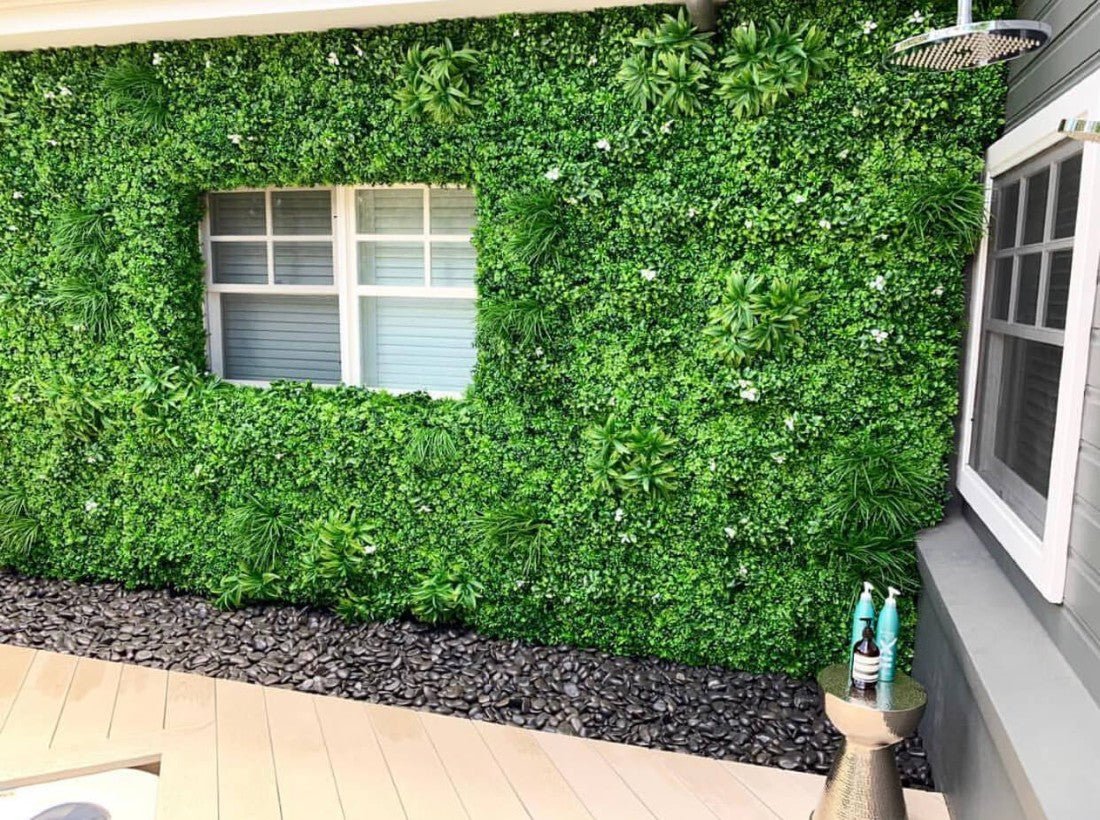Artificial green walls and vertical gardens have taken the world by storm, gracing the exteriors and interiors of buildings and infusing urban spaces with vibrancy.
But it wasn’t always like this. Green walls as we know them today are a relatively new invention, although similar forms can be traced far back in history. From the Hanging Gardens of Babylon to the modern artificial Country Fern by Designer Plants, the story of green walls is one brimming with innovation, beauty, and the intrinsic human desire to rope nature into our daily lives.
Are you ready to journey through time and witness the rapid rise of vertical gardens? We’ll explore historical facts and the impact they’ve had on today’s favorite design feature, so strap in and let’s roll!
What’s a Green Wall?
A green wall (aka a vertical garden) is a vertical structure covered in vegetation. Essentially, it’s a garden growing vertically that can be placed both indoors and outdoors. Usually, the plants grow in a special medium that enables them to thrive without needing as much soil as those in the ground.
One of the main reasons green walls shot up in popularity is because they’re great for the environment and help clear the air of pollutants. Aside from this, real and artificial vertical gardens insulate buildings and keep them cooler in the summer and warmer in the winter.
But how did it all come to be? Let’s see!
History of Green Walls
Like the ancient vines climbing up towering buildings, the history of green walls is as interlaced as it is beautiful. Indeed, its roots go back to our distant ancestors, the cavemen!
Cave Greenery
The first known sight of a “living wall” dates back to when our ancestors lived in caves. Back then, potted plants weren’t a must-have accessory, so people had to make do with what they had, which was natural greenery all over the cave walls!

In the forest, plant growth in caves begins when seeds and spores are carried in by the wind or by animals. As the plants grow, they cover the cave’s surface and provide food and shelter for various species. Aside from this, vegetation also helps to maintain humidity and temperature, thus creating a stable and self-sustaining ecosystem our ancestors loved.
Ancient Babylon
Real and artificial vertical gardens undoubtedly siphon inspiration from the Hanging Gardens of Babylon, one of the Seven Wonders of the Ancient World. Constructed in 600 BCE, the gardens were a love letter from king Nebuchadnezzar II to his beloved wife Amytis, who had been feeling nostalgic after immigrating from a land full of mountains and greenery.
The lush vegetation cascading down the imposing terraces helped Amytis feel more at home in the arid desert. Interestingly enough, there still isn’t concrete evidence to suggest the gardens were even in Babylon or were more than a fable in the first place, but one thing is certain - they inspired environments full of plants and a newfound love for foliage.
Love of Ivy
Even though monumental stone castles from the Middle Ages are striking on their own, medieval queens preferred the look of leafy ivy draped over walls, similar to their Babylonian predecessors. And as house plants gained popularity in the Victorian era, greenery became a prevalent addition to any residence.

This fad was most prominent amongst British mansions and castles. Scientists at Oxford conducted a sweeping study on the effects of ivy on the structural and aesthetic integrity of walls and proved that these plants serve a bioprotective role and act as an agent of thermal and moisture regulation. Just the push we needed to grab a gorgeous artificial trellis!
Garden City Movement
The 20th century was a pivotal moment in the history of vertical gardens in that this was the first time when greenery took on a larger role in society and urban planning. The garden city movement stipulates proportionate areas of industry, agriculture, and residence, enabling cities to become self-sufficient and establish the convergence between rural and urban.

The movement quickly gained traction and transcended the United Kingdom and the niche community that conceived it. As a result, many cities have adopted the idea and applied greenified design to some neighborhoods, including the communities of Residence Park and Garden City in NY, Woodbourne in Boston, Chatham Village in Pittsburgh, and many more.
The First System
In 1938, Stanley Hart White, a professor of Landscape Architecture at the University of Illinois patented the first green wall system called Botanical Bricks. His prototype was patented as the Vegetation-Bearing Architectonic Structure and System and served as the basis for the world’s first living wall. And he built it in his own garden!
Although White is the inventor of the green wall, his creation flew under the radar due to the unfavorable climate of the time and the large-scale industrialization of the post-war era. Fortunately, Richard Hindle recreated White’s first garden after writing this illuminating paper in 2012 to ensure Stanley’s invention would never be forgotten.
Coining Vertical Gardens
Patrick Blanc, a pioneering French botanist also took out a patent on his trademark hydroponic system, Mur Végétal, and raised the vertical garden to new heights. Essentially, he made the green wall what it is today and set the groundwork for a future of green design.

Blanc’s first installation was in 1986, around the time when the term “vertical garden” was coined to encapsulate a type of green wall that includes other design elements besides plants, like lighting. By looking at a couple of Blanc’s creations, it’s evident he takes inspiration from wild jungles, so if you’re also fascinated by tropical leaves, check out this Luxury Wild Tropics artificial green wall!
Rise of the Artificial
Times are rapidly changing, and so are we. Lately, the average person has become busier, more tired, and much more environmentally conscious. As a result, we’ve diverted our attention to green design features that don’t require back-breaking work and long hours and found artificial greenery.
While living walls already provide numerous environmental benefits, fake green walls take it up a notch and come in clutch when we aim to reduce water consumption, waste, and maintenance costs. After all, nobody loves worrying about natural growth patterns or seasonal changes. If you’re into the set-and-forget approach, our artificial vertical garden panels are waiting.
What Does the Future Hold?
As we look into the future, it’s clear that both real and artificial green walls will play an increasingly important role in sustainable urban design. In an attempt to bring nature into the hustle and bustle of city living, garden cities of the future will continue to build on green design and create a harmonious balance between leaves and concrete.
Soon enough, we might be looking at miles after miles of leafy sound barriers lining highways and major roads. And as a last-ditch effort to increase biodiversity and minimize the use of non-renewable resources, designers and architects will heavily lean into sustainability.

Although this might seem like a ways away, it’s already a reality in some places in the world, the most notable being Singapore. For example, the Parkroyal Pickering hotel (pictured above) features lush gardens pouring down the building’s façade, enhancing the beauty of the environment, and mitigating the urban heat island effect.
With artificial vertical gardens at the forefront, the future is bright. As we grapple with the challenges of urbanization and the looming threat of climate change, greenery provides a solution to creating livable cities for generations to come. And if this stunning design feature has inspired you to break out of your shell, get in touch today - we’re excited to open up a whole new world for you!


